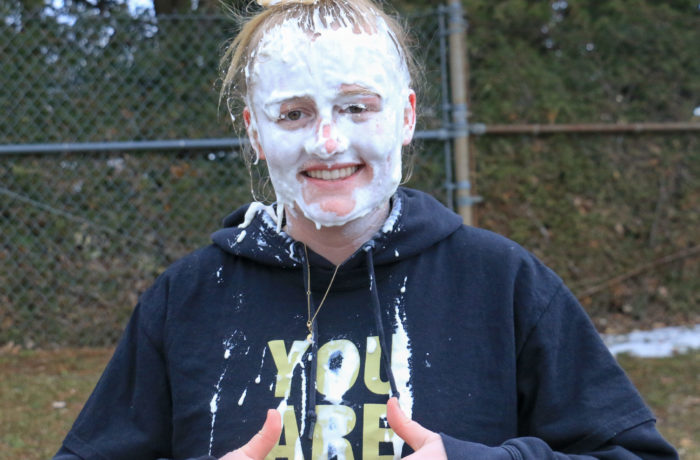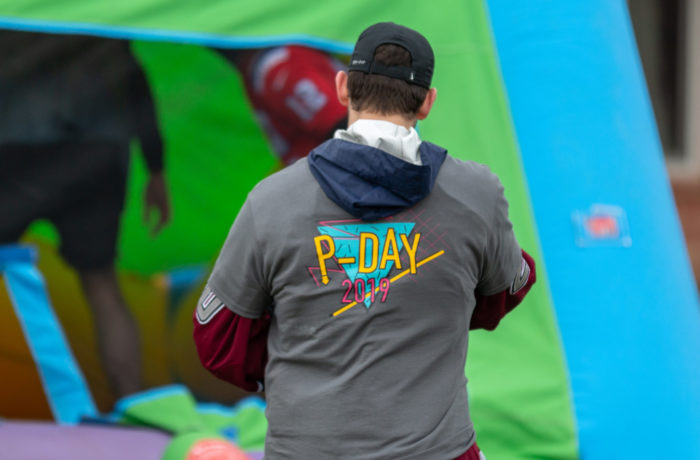By Eva Wilton
Executive Editor
Marlon Hyde ’21, felt vulnerable when recent stickers that read “It’s okay to be white” and “Embrace white identity today” appeared throughout campus on Feb. 18. He wasn’t alone.
“My friends didn’t feel safe sleeping last night,” Hyde said two days after the stickers were found. “Many of my friends don’t feel protected and are scared for their own safety.”
The stickers, which have appeared at campuses across the United States, including University of Vermont and Champlain College, appeared on the same weekend that the Black Panther movie was released. That needs to be taken into consideration, Hyde said, noting that the movie is the first to feature a black superhero.
The Department of Public Safety sent a statement on the night of Feb. 18 to all students, faculty, and staff and the following morning an email arrived from the president of the college. “According to news reports, [the stickers] began with a suggestion in an online chat space to seed social disruption and draw allies to white nationalist and alt-right causes,” said John Neuhauser, president of St. Michael’s College in the email.
“With the recent sticker incident, I felt it was important to reassure the community quickly that action was being taken and that we denounced the acts. I hope it provided some comfort to students who felt targeted and reassured them that it would not be tolerated, and that they belong here,” Neuhauser said in a later interview.

FREE SPEECH? A FLOOD OF BIAS REPORTS
Some members of the community questioned why the stickers are a problem.
“Understanding that the language is coded and there is a deeper meaning and it is a part of a movement that possibly hopes to recruit for white supremacists is concerning,” Leach said.
At St. Michael’s College, students and others in the community can fill out a bias report through Knightvision if they are concerned about an incident. In the past two weeks there were nine bias reports filed from eight students and one resident direct regarding the stickers, said Kerri Leach, assistant dean of students and facilitator of the Bias Response Team.
“I am concerned for those students who feel unsafe,” Leach said.
The Burlington Police Department has announced that the Federal Bureau of Investigations has identified some of the people involved and is still trying to identify others, Babcock said. “There is no current evidence to indicate that was someone from St. Michael’s College or any of the other area schools and it is believed to be someone from outside the state of Vermont.”
Leach said that despite the FBI investigation, students might feel affected by the incident.
The Student Association opened up their office for extended hours on Feb. 19, 20, 21 to allow for those that feel affected to know they can come speak with us about possible further actions the administration can take, said Sophie Adams ’18, president of the student association.
“I hope our community can see this as an opportunity to support people of color and those affected by this, by writing letters of support and calling out these actions as racist and intolerable on our campus,” Adams said.
UVM STUDENTS TAKE TO THE STREETS
At the University of Vermont, one staff member held a seven day hunger strike in support of students of color and demanding changes in diversity recruiting amongst staff and faculty, and other supports. One of three student protests over the last week took over and shut down Main Street in Burlington during evening traffic hours.
“It would not be appropriate for me to judge the UVM students’ actions or the administration’s response,” Neuhauser said. “I do not know all the facts; only what was has appeared in local media. I always think there is a place for temperate and reasoned dialogue.”
The Office of Student Life at St. Michael’s College held a mandatory meeting at the chapel on Feb. 19, the day following the discovery of the stickers. About 500 students attended. Some students chose not to go out of fear that they would be a target in such a large, single gathering following the wake of another mass shooting in Parkland, Fl.
The need for community was emphasized among the speakers. “Their hope is to dictate how we respond and spread chaos. They gave us an opportunity to come together to share our values,” said Moise St. Louis, associate dean of students and director of multicultural student services.
“They want us to hate and we show them how to love,” said St. Louis.

“I was grateful of how quickly Student Life and Campus Ministry organized the chapel meeting,” Neuhauser said. At the event organizers announced that Neuhauser was not in attendance because he had the flu.
The service was concluded by the passing out of You Count stickers that remind the need for safe spaces on campus.
On Monday night, a panel called What to do with the hate? held in the Roy Room served as an opportunity to bring conversation surrounding the recent bias event, Leach said.
MOVING FORWARD
“One bias report is too many,” Neuhauser said.“ My hope is that we always strive to provide a safe and aware environment for students to feel they belong and are able to thrive in their intellectual pursuits.”
“The institution did what they were supposed to do and brought as many people as they could to the chapel,” Hyde said. “But the problem is that people think that there is a violation of freedom of speech.”
“I don’t feel like much has changed,” Hyde said.
“What the community does moving forward is important, we cannot let this fizzle out until the next thing happens,” Leach said.


